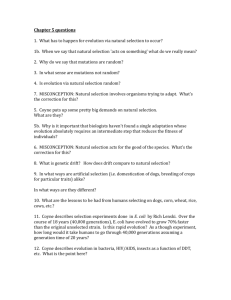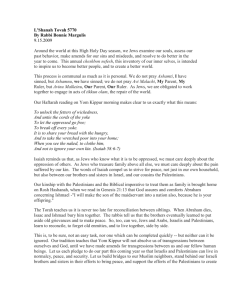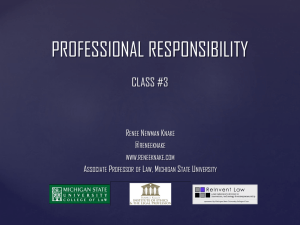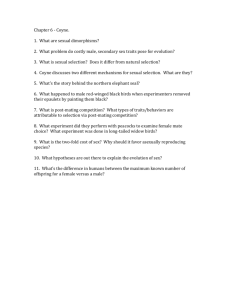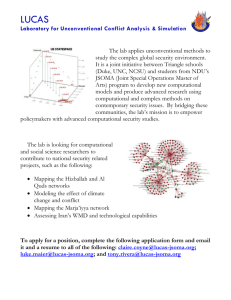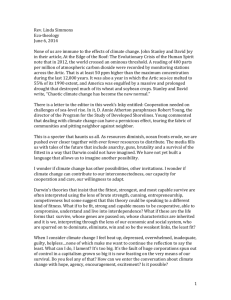TWO WRONGS (James MacAllister) On April 2011, University of
advertisement
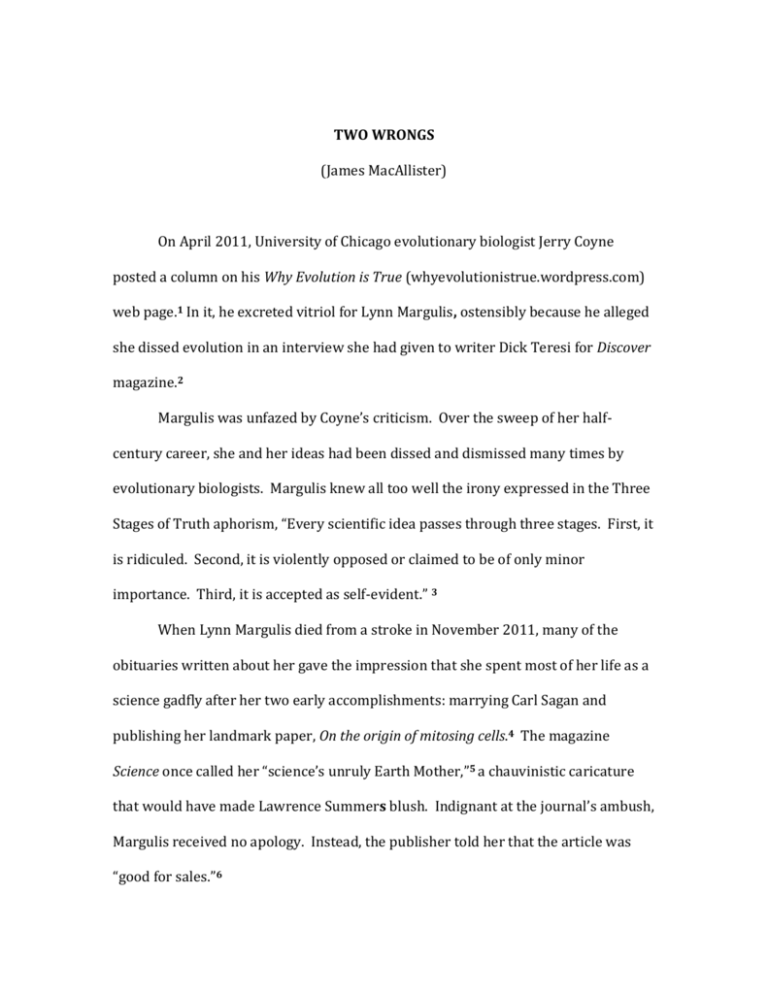
TWO WRONGS (James MacAllister) On April 2011, University of Chicago evolutionary biologist Jerry Coyne posted a column on his Why Evolution is True (whyevolutionistrue.wordpress.com) web page.1 In it, he excreted vitriol for Lynn Margulis, ostensibly because he alleged she dissed evolution in an interview she had given to writer Dick Teresi for Discover magazine.2 Margulis was unfazed by Coyne’s criticism. Over the sweep of her halfcentury career, she and her ideas had been dissed and dismissed many times by evolutionary biologists. Margulis knew all too well the irony expressed in the Three Stages of Truth aphorism, “Every scientific idea passes through three stages. First, it is ridiculed. Second, it is violently opposed or claimed to be of only minor importance. Third, it is accepted as self-evident.” 3 When Lynn Margulis died from a stroke in November 2011, many of the obituaries written about her gave the impression that she spent most of her life as a science gadfly after her two early accomplishments: marrying Carl Sagan and publishing her landmark paper, On the origin of mitosing cells.4 The magazine Science once called her “science’s unruly Earth Mother,”5 a chauvinistic caricature that would have made Lawrence Summers blush. Indignant at the journal’s ambush, Margulis received no apology. Instead, the publisher told her that the article was “good for sales.”6 Even Margulis’ death did not cool the rancor of her detractors. After reading Margulis’ obituary in the New York Times7, Richard Dawkins commented online that Margulis was right about “one big thing,” but she had used up her credibility “being wrong about almost everything else.”8 The press seemed to be casting her as a science martyr and gave her ideas a worrisome moment in the spotlight. Dawkins complained, “Sorry to sound grumpy about the dead, but this foolish obituary is enough to drive anyone to it.” 8 Symbiogenesis, the century-old science she championed, is at long last beginning to be taken seriously as a major cause of evolutionary novelty. Another University of Chicago Professor, James A. Shapiro, parts company with Coyne and Dawkins in his new book, Evolution: A View from the 21st Century. Shapiro, a molecular biologist, takes aim at Dawkins’ genes-eye view: “DNA + 0 0.”9 Genes alone (i.e., outside a cell and its environment) do nothing. Jerry Coyne in his book, Why Evolution is True, simply leaves symbiosis and symbiogenesis out of what he presents as the complete explanation of biological evolution. He also omits planet Earth, epigenetics and anything that contradicts neodarwinist dogma. He is incapable of thinking outside-the-neodarwinist box. One of many examples of Coyne wearing blinders is his explanation of the “sinister tactics” of some “adaptations.” His example is a roundworm that “parasitizes” a Central American ant. Once “infected” by the roundworm the ant undergoes “radical change” to its behavior, shape, structure, chemistry and color. The black ant is transformed into a red faux berry attractive to birds. (It sounds almost as if the ant is undergoing metamorphosis). “All of these changes are caused by the genes of the roundworm to reproduce themselves.”10 Neodarwinists love to apply human emotions and motivations to evolution: sinister adaptation, altruism, selfish genes? Is this science? Margulis often pointed out that parasitism, commensualism and mututalism were examples of “misplaced concreteness:” terms that gave the user the sense that they were accurately and precisely describing a complex, temporal, dynamic, two-way relationship in which the roundworm is also very likely being changed by the ant. How does Coyne explain the stasis of these ants given the selection pressure of roundworms? This contradicts other statements he makes in the same chapter that selection produces adaptations are “endless” and “staggering.”10 Nonetheless, Coyne fails to see how this early “infection” (i.e.,necrotrophic symbiosis) may change over time and present the opportunity to recombine the working genes of two organisms. Margulis liked to explain the math of biology: 1 + 1 = 1 (e.g., 1 egg + 1 sperm = 1 fertilized egg). Coyne and Dawkins, two crusaders against religion and creationism, share with fundamentalists what Maturana and Varela in their book, Tree of Knowledge, call the temptation of certainty.11 It is one thing to be adamant, but yielding to this temptation spells the death of a scientific mind. To quote Claude Bernard, “Men who have excessive faith in their theories or ideas are not only ill prepared for making discoveries; they also make very poor observations. Of necessity, they observe with a preconceived idea, and when they devise an experiment, they can see, in its results, only a confirmation of their theory. In this way they distort observation and often neglect very important facts because they do not further their aim.”12 This isn’t always true, but for best-selling authors of neodarwinist texts there is always the temptation to think that what you parrot in print about evolution must be true. After all, you are asked by the New York Times to review books on evolution or you are the media darling when a sound bite about evolution is needed. It is not that Coyne and Dawkins are completely wrong in their faith in the Modern Synthesis of the 1930s, the neodarwinian marriage of Darwin and Wallace’s “descent with modification” (i.e.,change) to the genetics of Gregor Mendel (i.e., stasis). Lynn Margulis was quick to admit that the extremely long odds against the accumulation of random beneficial mutations being the source of most evolutionary novelty did not mean it never happened.13 It is certainly more likely in bacteria where reproduction is fast (a generation in as little as every 15 minutes), and “promiscuous,” genderless, species-less sex has been going on planet-wide in these little buggers for 3800 million years. Unlike Jerry Coyne and Richard Dawkins, Lynn Margulis avoided such absolutes as every, all, always, never or none. She was equally wary of the human tendency to dichotomize nature (e.g., plant or animal, male or female, right or wrong, this or that). During the Homage to Darwin debate on evolution at Oxford in 2009, she said that single answers were the result of “test-itis.” Richard Dawkins asked, “You don't mean testosterone-itis?” Margulis, “Maybe that, too. [laughter] No, it's only on tests that there's one correct answer that's definitive.”13 Lynn Margulis joked in her Discover interview that neo-Darwism was “a minor twentieth-century religious sect within the sprawling religious persuasion of Anglo-Saxon biology.”2 It is no surprise that Coyne, a zealot of the faith, got his panties all in a bunch when he read such blasphemy. In his online column, he complained, “Since she’s famous, she’s invited many places, and often uses these occasions to dump on modern evolutionary biology. In this respect she may be worse for science than creationists, since her scientific credibility remains high.”1 It appears lost on Coyne that he and Richard Dawkins are also famous, are invited many places, and often use these occasions to ignore, trivialize or denigrate ideas about evolution with which they disagree. Evolutionary biologists have taken the life out of biology. They suffer from physics envy: borrowing such things as “cost-benefit analysis” from the hard science of economics to quantify life. The tallies they came up with were called “average effects.” It is hard to imagine that as a book title. Richard Dawkins transformed 542 million years of random, statistically plotted, gradual, incremental, plodding evolution into the more “deep-throated” gold with the alchemically rakish “selfish gene.”14 Jerry Coyne sees himself as Guardian of Science who gallantly protects Truth and Science from the creationist menace. Even if Margulis made only one major contribution to science, that is one more than Coyne or Dawkins. Margulis viewed evolution as a scientific fact in the same way that gravity is a fact.15 They do differ: saying you do not believe in gravity will hurt your chances to run for President of the United States. Wallace and Darwin had a theory that explained the how and why of biological evolution, neodarwinists have another, and Margulis had a third. Thankfully, in real science there are still debates; granted, they are becoming rarer and, unhappily, if you take the side that departs from the consensus, you are likely to discover that an open, inquisitive mind convinced by evidence, not consensus an authority, may well be regarded as heretical. According to Jerry Coyne, a paper authored by marine biologist, Donald Williamson, epitomized the case against Lynn Margulis’ credibility. Coyne states that she “forc[ed] it into publication despite dissenting referees.”1 In the paper, Williamson posits that lepidopteran larvae (i.e., caterpillars) were originally separate species akin to velvet worms that hybridized with an ancestor of butterflies.16 Coyne parenthetically claims that Williamson’s paper was “debunked.”1 First is the issue of Margulis getting a paper published in the Proceedings of the National Academy of Science (PNAS) “despite dissenting referees.” The editorin-chief of the PNAS, Randy Schekman, received a single complaint letter by an anonymous NAS member who quoted from an article in Scientific American with the decidedly biased title, “National Academy as National Enquirer? PNAS Publishes Theory That Caterpillars Originated from Interspecies Sex.”17 In the article, the author, Brendan Borrell wrote that “[Margulis] says it took ‘6 or 7’ peer reviews before she had the ‘2 or 3’ positive ones necessary to make a case for its publication.”18 The statement has two quotes by Lynn Margulis: “6 or 7” and “2 or 3.” The rest of the sentence is a context constructed by the reporter. If Margulis said something that controversial, why didn’t Borrell ask her to clarify what she meant, so he could quote her? Perhaps, promoting a controversy was “good for sales:”: a case of Scientific American as The National Enquirer. In the end, Margulis was held to the highest standards and satisfied the PNAS that she had not violated the review process by which all NAS (National Academy of Sciences) members were allowed to “communicate” papers for publication. How good were the paper’s reviewers? Margulis described her primary reviewer, “Professor Emeritus, Robert Higgins, arguably the best invertebrate biologist alive, a quiet effective Smithsonian type, the only scientist to have discovered and named a phylum in the 20th century (the Loricifera, a lophophorate phylum of meiofauna)…”19 Coyne, who makes a habit of erring by omission, cherry-picked the “facts” he used in his online column. It is true that the PNAS decided to discontinue papers communicated by NAS members and makes all submissions to Proceedings follow their direct submission process. However, contrary to what is repeated in many anti-Margulis tracts, this decision had nothing to do with the Williamson paper.20 Williamson’s paper, Caterpillars evolved from onychophorans by hybridogenesis, was published in the November 29, 2009 issue of the PNAS after a review process lasting 4 months. A paper by Michael Hart and Richard Grosberg, Caterpillars did not evolve from onychophorans by hybridogenesis, appeared in the very same issue after a review process of only a month. The fact that Hart and Grosberg’s paper appeared to have been solicited and whisked through the review process at the PNAS stirred no controversy. Coyne judged the Williamson paper “the worst paper of the year,”1 but it seems reasonable to conclude that Coyne would feel the same way about any unorthodox (e.g., non-neodarwinist) hypothesis. In the rush to “debunk” Williamson’s larval transfer idea, Hart and Grosberg decided to concentrate on what they felt was the strongest evidence against Williamson: his predictions of genome sizes in animals with larval stages. However, the genome sizes they compared were the “C values” (total mass of coding and non-coding DNA, including repetitive sequences, per haploid genome) rather than the complete proteomes.21 Williamson points out in a reply to the Hart and Grosberg paper, “I did not refer to any data in the animal genome database of C-values, not only because non-coding DNA constitutes such a disproportionately large percentage of these values but also because a proper study must be based on the protein-sequence level where functional enzyme active sites, insertions and deletions and other clues to relevant genotype-phenotype developmental data in a biological context are compared. My data came from draft genome sequences of the animals concerned, and my article gives the relevant references.”22 In the interest of science, or perhaps to avoid the embarrassment of such a elementary mistake by both the authors and their reviewers, the PNAS refused to publish Williamson’s reply. Coyne, the “expert” on how genes determine ontogeny, variation and evolution, also missed this fundamental flaw. Coyne’s next knock on Margulis’ credibility is that she “even wrote a book on speciation, Acquiring Genomes, suggesting that the critical [sic] factor in the origin of species was endosymbiosis... I was asked to review it for The New York Times, but it was … so completely ignorant of decades of work on speciation (including observations that reproductive barriers nearly always map to genes, not cytoplasmic organelles)… although I enjoy writing for the Times, I refused on this occasion. I didn’t want to publicize such a misguided book.”1 Coyne might have noted, in the interest of full disclosure, that he is the co-author of a competing textbook, Speciation, which ignores decades of work on symbiogenetic speciation. He is wrong that there is a claim that “cytoplasmic organelles produce barriers to reproduction” in Aquiring Genomes.21 However, there is the fact that almost all experiments in cross-species animal clones fail. It is exceedingly rare that the fertilized nucleus (already more than DNA alone) produces an animal when placed in the cytoplasm of an egg cell from a different species of animal.24 Coyne avoids consistency in his rules for censorship: he cheerfully gives publicity and even a link to Margulis’ Discover interview that he claims is filled with “dreadful stuff.”1 At the top of the list is Margulis’ idea that Acquired Immune Deficiency Syndrome (AIDS) might involve the kinds of bacteria (spirochetes) that cause syphilis and Lyme disease. This is some easy mud to sling even if Coyne is uncritically clueless about any of the many HIV hypotheses. Margulis was an expert on spirochetes and along with colleagues, such as Morten Laane in Norway, showed that spirochetes may survive antibiotic treatment.25 HIV was a newly discovered retrovirus, when it was announced to be the “probable cause of AIDS ” in 1984 without a single peer-reviewed paper in the medical literature to back up the claim.26 Margulis is not the first or alone in questioning the HIV=AIDS hypothesis. National Academy of Science member, Peter Duesberg, was acknowledged to be one of top medical researchers in the world, an expert on “oncogenes” and cancer virology, but once he “began to question the widely accepted role of oncogenes as the cause of cancer, his colleagues began to give him the cold shoulder.“27 At the time, research funds for the War on Cancer were drying up. HIV was a godsend to medical researchers who desperately needed to keep government grant money flowing into their labs. Duesberg’s skepticism was portrayed as immoral and doing harm patients, but what really got him into hot water was that his scientific critique of the HIV hypothesis jeopardized the livelihoods of researchers, endangered budgets for laboratories and might have effected the soon-to-be-realized bonanza in profits for Big Pharma. Duesberg would be the first scientist to have his conservative caution rebranded as “AIDS denialism,” his grants were cut, and his reputation smeared by a well-oiled McCarthyism-style blacklisting which has effectively silenced nearly all debate about the constantly moving goal posts of HIV hypotheses.28 Margulis and Duesberg’s skepticism of HIV=AIDS is shared by Luc Montagnier, recipient of the Nobel Prize for his discovery of HIV. Robert Gallo was conspicuously absent in the Nobel Prize because his papers on HIV had been found to be a case of scientific fraud. Montagnier has stated (unedited) on camera, "We can be exposed to HIV many times without being chronically infected. Our immune system will get rid of the virus in a few weeks, if you have a good immune system.”29 If HIV can be thwarted by a healthy immune system, it would seem reasonable to ask what co-factors cause the healthy immune system to collapse allowing HIV to proliferate? But let us follow Coyne’s lead and concentrate on what he calls Margulis’ “evolution-dissing,” where he claims she “sounds awfully like a creationist.”1 Creationists do not believe in the fact of evolution. They believe that all life (fossil or alive) has remained as it was designed in the beginning and that all the wear and tear on Earth has happened in only 6000 years. Margulis shared no point of agreement with any of this. Coyne is using a false dichotomy (i.e., you are either a neodarwinist or you are a creationist). There are many other points-of-view (e.g., Darwin was nor a neodarwinist). Coyne is flummoxed, “[W]here on earth does Margulis get the idea that artificial selection shows that ‘natural selection doesn’t create’? Artificial selection, of course, does create…”1 But he then presents examples of varieties of the same species where breeders have exaggerated various traits. This does not explain how the trait came about or how species originate. A sculptor’s clay can be molded into something beautiful or grotesque, but it is still clay. Nature (i.e., the environment) selects fewer, not more choices of clay. Then Coyne delivers the big “if.” “[I]f those changes increased fitness in nature, as for example the combination of traits that turned an ancestral artiodactyl into a whale, why wouldn’t natural selection create something new?”1 Nearly all gene mutations are harmful. The odds against an accumulation of random beneficial mutations are staggering—no better than guessing the right atom out of all the atoms in the universe.30 Earth cannot support the prodigious progeny of any organism. Choices of phenotype are reduced leaving certain phenotypes. The fossil record shows that things change, not how variations arise or what caused them. Coyne, who has demonstrated that he does not understand “natural selection” or what the evidence of the fossil record attests to, claims Margulis “simply doesn’t understand punctuated equilibrium.” How so? Because “no exponent of punctuated equilibrum—not Gould, not Eldredge, not my own colleagues here in Chicago—would say that the observation of ‘jerky’ evolution vitiates natural selection.”1 The only problem is that Coyne’s argument is a “straw man”: Margulis not only believed in natural selection, she understood how it acts. Then Coyne gets creative: he combines a false dichotomy, guilt by association and fallacious ad hominem arguments to come up with this remarkable example of intellectual dishonesty, “Margulis agrees with the creationists about the inefficacy of selection and of the neodarwinist paradigm…Well, at least she’s not crazy enough to accept god as a scientific explanation. But she is crazy enough to proffer her ‘alternative’ theory, which of course is symbiosis.” 1 Without intending to, Coyne then constructs a very nice prima facie case for how symbiogenesis explains speciation, with the exception that he makes the logical fallacy of yet another false dichotomy: he claims that if “symbiosis (i.e., “symbiogenesis”) were the case, major evolutionary innovations would arise instantly, and by ‘instantly’ I mean within a few generations.”1 In fact, there are examples of symbiogenesis that occur in one generation (e.g., Hatena arenicola31), but that does not mean that symbiogenesis (the incorporation the whole or parts of a new working genome) cannot also occur over geological periods of time or anything in between. By this point in Coyne’s hissy fit, he arrives at the cusp between stage two and three of the Three Stages of Truth aphorism where the once ridiculed, violently opposed theory is claimed to be of minor significance on its way to becoming something that “we knnew all along.” Coyne, without attribution to Margulis (or a century of symbiogeneticists) assures us, “Yes, that’s what happened when bacteria and mitochondria became organelles in cells, and we occasionally do see the rapid origin of species through hybridization…But these events are not the rule, as Margulis implies, but…very rare occurrences.”1 He has no proof that symbiogenesis is rare. Coyne goes on with a genuine slew of dreadful stuff: he calls Margulis an insane demagogue, he invents immutable good genes (are they selfish?), confuses the fact that genes do things with proof of how they arrived in the genome, he plugs his textbook again and engages in some “she said, he said” over comments Margulis claims were made by Coyne’s Ph.D. advisor, Dick Lewontin, “that really bothered me.”1 I was not there, so I cannot verify what was said by Lewotin. I had heard Lynn Margulis tell this story long before the Discover interview. Coyne says that Richard Lewontin disputes Lynn Margulis’ characterization, but according to Coyne, Lewontin also claims “Margulis knows nothing of his work.” That is most assuredly not true. It too is another overreaching absolute claim and a false dichotomy. It would be the equivalent of me writing that Coyne knows nothing of Margulis’ work. He knows something about it; he even has a tiny bit of that right! I’m not sure how much Richard Dawkins knows about symbiosis, but he has most of it wrong. When I read Coyne’s online column, designed to denigrate Margulis and symbiogenetics, I did not recognize at all the caricature he had drawn and it bothered me. He simply distorted Margulis’ views, which I have just described, as another way of dismissing current thinking about environmental evolution, the trend toward symbiogenetics and systems and away from neodarwinism.32 When Coyne discusses evolutionary biology (neodarwinism), he is dogmatic and willfully ignorant of the fact that evolutionary biology is only a tiny subfield of the study of evolution. He is both intellectually dishonest and a hypocrite when he claims Margulis is “simply wrong—and wrong in the worst way a scientist can be wrong: ignoring all the data that go against her theories.” Ironically, this characterization is a shoe that seems to fit Coyne. At long last. Neodarwinism, the once- useful hypothesis which over the decades sclerosed into dogma, delusion and denial, has lost out to the richer and more inclusive 21st century view of evolution.33 References 1. Jerry Coyne (2011) “Lynn Margulis disses evolution in Discover magazine, embarrasses both herself and the field,” Why Evolution is True http://whyevolutionistrue.wordpress.com/2011/04/12/lynn-margulisdisses-evolution-in-discover-magazine-embarrasses-both-herself-and-thefield/ accessed 12/05/2012 2. Dick Teresi (2011) “Lynn Margulis,” Discover magazine, April, pp. 66–71. 3. Jeffrey Shallit (2005) Science, Pseudoscience, and The Three Stages of Truth Department of Computer Science, University of Waterloo, Ontario, Canada www.cs.uwaterloo.ca/~shallit/Papers/stages.pdf accessed 12/05/2012 4. Lynn Sagan (1967) On the origin of mitosing cells. Journal of Theoretical Biology Volume 14, Issue 3, March 1967, Pages 225-274 5. Charles Mann (1991) “Lynn Margulis: Science’s Unruly Earth Mother,” Science April 19, 252:pp378-381 6. Lynn Margulis personal communication 7. Bruce Weber (2011) Lynn Margulis, Evolution Theorist, Dies at 73. New York Times, November 24 8. Richard Dawkins Why Evolution is True (in reply to comment #3) http://whyevolutionistrue.wordpress.com/2011/11/24/rip-lynn-margulisctd/#comment-157833 accessed 1/05/2012 9. James A. Shapiro (2011) Evolution: A View from the 21st Century (p. 24). FT Press, Upper Saddle River, NJ 10. Jerry Coyne (2009) Why Evolution Is True (pp.123-124). Oxford University Press 11. Humberto Maturana and Francisco Varela (1998) The Tree of Knowledge: The Biological Roots of Human Understanding (pp. 17-18). Translated by Robert Paolucci. Shambhala Publications, Boston, MA. 12. Claude Bernard (1957) An Introduction to the Study of Experimental Medicine. Dover Publications: Mineola, NY. 13. Lynn Margulis (2009) Homage to Darwin debate on evolution, Part 3. Voices from Oxford. 14. David Sloan Wilson (2007) Evolution for Everyone: How Darwin’s Theory Can Change the Way We Think About Our Lives (p. 40). Delacorte Press, Bantam Dell, NY. 15. Ludwig Fleck (1979) Genesis and Development of a Scientific Fact. University of Chicago Press. 16. Donald Williamson (2009) “Caterpillars evolved from onycophorans.” PNAS November 24, 106:19904-19905 17. Randy Schekman, editor-in-chief of PNAS in a letter to Dr. Lynn Margulis dated September 4, 2009. 18. Brendan Borrell (2009) “National Academy as National Enquirer? PNAS Publishes Theory That Caterpillars Originated from Interspecies Sex.” Scientific American, August 29. http://www.scientificamerican.com/article.cfm?id=national-academy-asnational-enquirer accessed 1/7/2012. 19. Lynn Margulis in an email to Professor Denis Noble dated September 5, 2009 4:55:22 AM EDT. 20. John Matson (2009) “Controversial caterpillar-evolution study formally rebutted.” Scientific American Observations, October 29. http://blogs.scientificamerican.com/observations/2009/10/29/controversi al-caterpillar-evolution-study-formally-rebutted/ accessed 1/6/2012. 21. Hart and Grosberg (2009) “Caterpillars did not evolve from onycophorans.” PNAS. November 24, 106:19906–19909. 22. Donald Williamson (2009 ) “Weights of DNA, genome sequences, and phylogeny.” Reply to Hart and Grosberg (2009) “Caterpillars did not evolve from onycophorans.” PNAS. November 24, 106:19906–19909. Refused for publication by the PNAS. Available as a google document http://goo.gl/SYvym. 23. Lynn Margulis and Dorion Sagan (2003) Acquiring Genomes: A Theory of the Origin of Species. Basic Books, New York, NY. 24. Denis Noble (2009) Homage to Darwin debate on evolution. Voices from Oxford. Part 3. 25. Morten Laane et al (2009) “Borrelia og Lyme-borreliose: morfologiske studier av enfarlig spirochet.” Biolog, 2, pp.30-45. 26. John Crewdson (2002) Science Fictions. Little, Brown & Company, New York, NY. 27. Jeanne Lenzer (2008) AIDS "Dissident" Seeks Redemption... and a Cure for Cancer : Biologist Peter Duesberg was all but banished from science for his views on HIV. Discover June 2008 issue; published online May 15, 2008 http://discovermagazine.com/2008/jun/15-aids-dissident-seeksredemption-and-a-cure-for-cancer accessed 1/6/2012. 28. Liam Scheff (2007) “John P.Moore, Aids Denialist.” The AIDS Investigation. http://liamscheff.com/2007/11/john-p-moore-aids-denialist-and-azt-walkslike-thalidomide/ accessed 1/6/2012 29. Brent Leung (2009) un-cut footage of interview with Luc Montagnier from the documentary "House of Numbers" Posted on YouTube by NaturalNews.com http://www.youtube.com/watch?v=WQoNW7lOnT4. 30. Denis Noble (2009) Homage to Darwin debate on evolution. Voices from Oxford. Part 1. 31. Okamoto N and Inouye I (2006) “Hatena arenicola gen. et sp. Nov., a Katablepharid Protist Undergoing Probable Plastid Acquisition.” Protist. 157:401-19. 32. James A. Shapiro (2011) Evolution: A View from the 21st Century (p. 24-26). FT Press, Upper Saddle River, NJ. 33. James A. Shapiro (2011) Evolution: A View from the 21st Century (p. 145). FT Press, Upper Saddle River, NJ.
